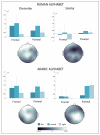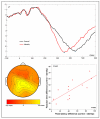Neural correlates of visual versus abstract letter processing in Roman and Arabic scripts
- PMID: 23806176
- PMCID: PMC3837287
- DOI: 10.1162/jocn_a_00438
Neural correlates of visual versus abstract letter processing in Roman and Arabic scripts
Abstract
In alphabetic orthographies, letter identification is a critical process during the recognition of visually presented words. In the present experiment, we examined whether and when visual form influences letter processing in two very distinct alphabets (Roman and Arabic). Disentangling visual versus abstract letter representations was possible because letters in the Roman alphabet may look visually similar/dissimilar in lowercase and uppercase forms (e.g., c-C vs. r-R) and letters in the Arabic alphabet may look visually similar/dissimilar, depending on their position within a word (e.g., [Formula: see text] - [Formula: see text] vs. [Formula: see text] - [Formula: see text]). We employed a masked priming same-different matching task while ERPs were measured from individuals who had learned the two alphabets at an early age. Results revealed a prime-target relatedness effect dependent on visual form in early components (P/N150) and a more abstract relatedness effect in a later component (P300). Importantly, the pattern of data was remarkably similar in the two alphabets. Thus, these data offer empirical support for a universal (i.e., across alphabets) hierarchical account of letter processing in which the time course of letter processing in different scripts follows a similar trajectory from visual features to visual form independent of abstract representations.
Figures





References
-
- Bowers JS, Vigliocco G, Haan R. Orthographic, phonological, and articulatory contributions to masked letter and word priming. Journal of Experimental Psychology: Human Perception and Performance. 1998;24:1705–1719. - PubMed
-
- Carreiras M, Duñabeitia JA, Molinaro N. Consonants and vowels contribute differently to visual word recognition: ERPs of relative position priming. Cerebral Cortex. 2009;19:2659–2670. - PubMed
-
- Carreiras M, Perea M, Abu Mallouh R. Priming of abstract letter representations may be universal: The case of Arabic. Psychonomic Bulletin and Review. 2012;19:685–690. - PubMed
Publication types
MeSH terms
Grants and funding
LinkOut - more resources
Full Text Sources
Other Literature Sources
Miscellaneous

